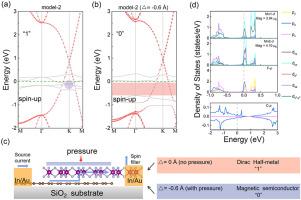Broken sublattice symmetry induced gap opening of spin-polarized Dirac cone in MnF3
IF 2.9
3区 物理与天体物理
Q3 NANOSCIENCE & NANOTECHNOLOGY
Physica E-low-dimensional Systems & Nanostructures
Pub Date : 2025-09-29
DOI:10.1016/j.physe.2025.116382
引用次数: 0
Abstract
Two-dimensional (2D) transition-metal trihalides have received extensive attention in the field of novel spintronic devices and heterostructure coupling is an effective method for achieving multifunctional integration and regulation. In this work, using first-principles calculations, we systematically study the electronic structure and magnetic properties of the 2D MnF3/graphene heterostructures. MnF3 monolayer exhibits Dirac half-metal properties, with electron states featuring Dirac cones in its single spin channel. With different stacking configurations, the electronic properties of both are well preserved from the band structure, interfacial charge transfer only causes the relative movement of the electronic states. Additionally, due to the broken sublattice symmetry of MnF3 in heterostructure, a gap opening of 24.9 meV appears around the spin-polarized Dirac cone in MnF3. Moreover, the formation of heterostructure significantly enhances the in-plane magnetic anisotropy of the MnF3 monolayer. By reducing the interlayer distance, the spin-polarized Dirac cone has a larger gap opening of 555.5 meV, which induces the transition of MnF3 from Dirac half-metal to magnetic semiconductor, and the Curie temperature (TC) increases obviously. Furthermore, a spin logic device based on MnF3/graphene heterostructures is proposed, which can complete the resistive state switching from the "1″ state to the "0″ state by application of pressure. These results provide a reference for the application of MnF3/graphene heterostructure in spintronic devices.

亚晶格对称性破缺诱导MnF3中自旋极化Dirac锥的隙开
二维过渡金属三卤化物在新型自旋电子器件领域受到广泛关注,异质结构耦合是实现多功能集成和调控的有效方法。在这项工作中,我们使用第一性原理计算,系统地研究了二维MnF3/石墨烯异质结构的电子结构和磁性能。MnF3单层膜具有狄拉克半金属性质,其单自旋通道的电子态具有狄拉克锥。在不同的堆叠构型下,从能带结构上看,两者的电子性质都得到了很好的保留,界面电荷转移只引起电子态的相对运动。此外,由于MnF3异质结构中亚晶格对称性的破坏,在MnF3中自旋极化的Dirac锥周围出现了24.9 meV的隙开。此外,异质结构的形成显著增强了MnF3单层的面内磁各向异性。通过减小层间距离,自旋极化的Dirac锥隙开度增大至555.5 meV,诱导MnF3从Dirac半金属向磁性半导体转变,居里温度(TC)明显升高。此外,提出了一种基于MnF3/石墨烯异质结构的自旋逻辑器件,该器件可以通过施加压力完成从“1″”状态到“0″”状态的电阻性状态切换。这些结果为MnF3/石墨烯异质结构在自旋电子器件中的应用提供了参考。
本文章由计算机程序翻译,如有差异,请以英文原文为准。
求助全文
约1分钟内获得全文
求助全文
来源期刊
CiteScore
7.30
自引率
6.10%
发文量
356
审稿时长
65 days
期刊介绍:
Physica E: Low-dimensional systems and nanostructures contains papers and invited review articles on the fundamental and applied aspects of physics in low-dimensional electron systems, in semiconductor heterostructures, oxide interfaces, quantum wells and superlattices, quantum wires and dots, novel quantum states of matter such as topological insulators, and Weyl semimetals.
Both theoretical and experimental contributions are invited. Topics suitable for publication in this journal include spin related phenomena, optical and transport properties, many-body effects, integer and fractional quantum Hall effects, quantum spin Hall effect, single electron effects and devices, Majorana fermions, and other novel phenomena.
Keywords:
• topological insulators/superconductors, majorana fermions, Wyel semimetals;
• quantum and neuromorphic computing/quantum information physics and devices based on low dimensional systems;
• layered superconductivity, low dimensional systems with superconducting proximity effect;
• 2D materials such as transition metal dichalcogenides;
• oxide heterostructures including ZnO, SrTiO3 etc;
• carbon nanostructures (graphene, carbon nanotubes, diamond NV center, etc.)
• quantum wells and superlattices;
• quantum Hall effect, quantum spin Hall effect, quantum anomalous Hall effect;
• optical- and phonons-related phenomena;
• magnetic-semiconductor structures;
• charge/spin-, magnon-, skyrmion-, Cooper pair- and majorana fermion- transport and tunneling;
• ultra-fast nonlinear optical phenomena;
• novel devices and applications (such as high performance sensor, solar cell, etc);
• novel growth and fabrication techniques for nanostructures

 求助内容:
求助内容: 应助结果提醒方式:
应助结果提醒方式:


